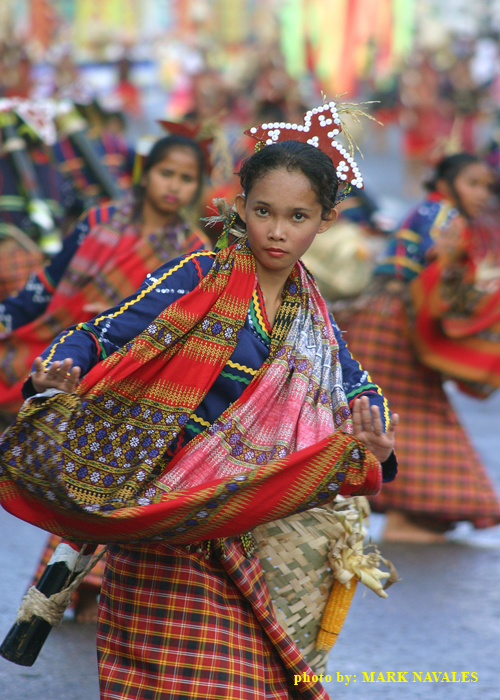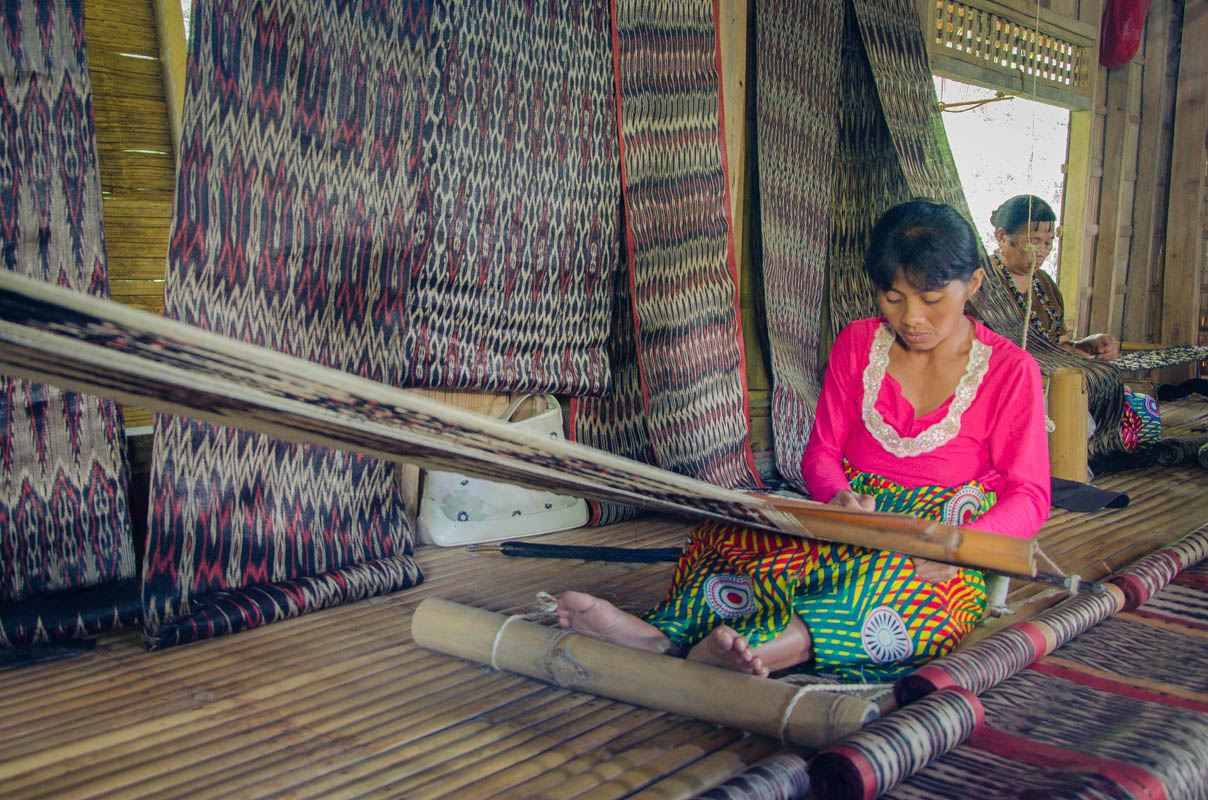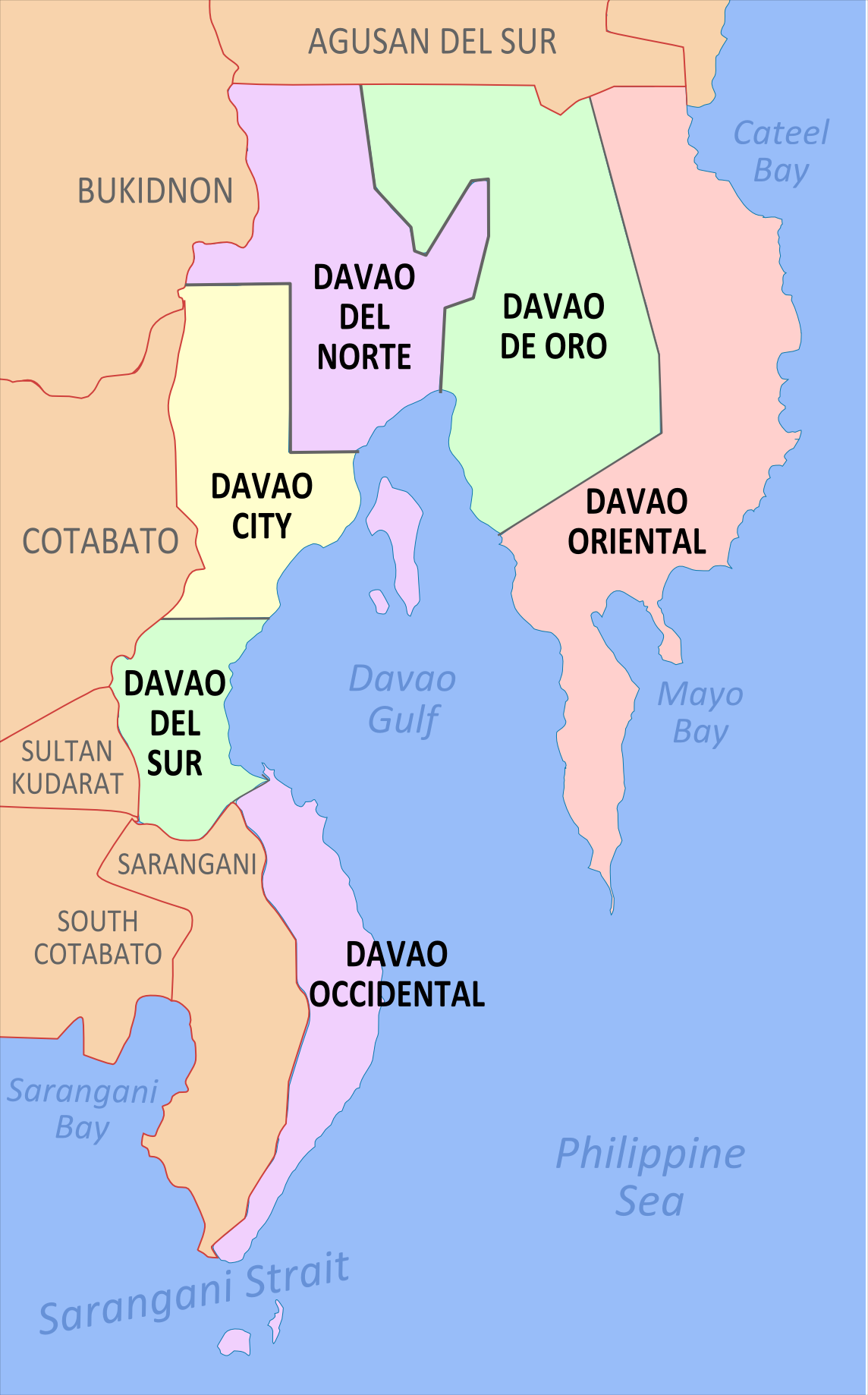|
Blaan People
The Blaan people, are one of the indigenous peoples of Southern Mindanao in the Philippines. Their name could have derived from "bla" meaning "opponent" and the suffix "an" meaning "people". According to a 2021 genetic study, the Blaan people also have Papuan admixture. Classification The Blaan are neighbors of the T'boli, and live in Lake Sebu and T'boli municipalities of South Cotabato, Sarangani, General Santos City, the southeastern part of Davao and around Lake Buluan in North Cotabato. They are famous for their brassworks, beadwork, and tabih weave. The people of these tribes wear colorful embroidered native costumes and beadwork accessories. The women of these tribes, particularly, wear heavy brass belts with brass "tassels" ending in tiny brass bells that herald their approach even when they are a long way off. History Some Blaan natives were displaced when General Santos City was founded in 1939. Others settled in the city. Their language is said to be the source of ... [...More Info...] [...Related Items...] OR: [Wikipedia] [Google] [Baidu] |
Sarangani
Sarangani, officially the Province of Sarangani ( ceb, Lalawigan sa Sarangani; hil, Kapuoran sang Sarangani; Maguindanaon: ''Dairat nu Sarangani'', Jawi: دايرت نو سارڠني; fil, Lalawigan ng Sarangani), is a province in the Philippines located in the Soccsksargen region. Its capital is Alabel. With a coastline along the Sarangani Bay and Celebes Sea, the province is at the southernmost tip of Mindanao island, and borders South Cotabato and Davao del Sur to the north, Davao Occidental to the east, and the Celebes Sea to the south. Sarangani is part of the South Cotabato-Cotabato-Sultan Kudarat-Sarangani-General Santos () development cluster, and is linked by paved roads to the international airport and harbor of General Santos. The province is divided into two sections, separated by the Sarangani Bay and city of General Santos, and it used to be part of South Cotabato until it was made an independent province in 1992. The General Santos Metropolitan Area or Met ... [...More Info...] [...Related Items...] OR: [Wikipedia] [Google] [Baidu] |
Visayans
Visayans (Visayan: ''mga Bisaya''; ) or Visayan people are a Philippine ethnolinguistic group or metaethnicity native to the Visayas, the southernmost islands of Luzon and a significant portion of Mindanao. When taken as a single ethnic group, they are both the most numerous in the entire country at around 33.5 million, as well as the most geographically widespread. The Visayans broadly share a maritime culture with strong Roman Catholic traditions integrated into a precolonial indigenous core through centuries of interaction and migration mainly across the Visayan, Sibuyan, Camotes, Bohol and Sulu seas. In more inland or otherwise secluded areas, ancient animistic-polytheistic beliefs and traditions either were reinterpreted within a Roman Catholic framework or syncretized with the new religion. Visayans are generally speakers of one or more of the Bisayan languages, the most widely spoken being Cebuano, followed by Hiligaynon (Ilonggo) and Waray-Waray. Terminology '' K ... [...More Info...] [...Related Items...] OR: [Wikipedia] [Google] [Baidu] |
Cogon Grass
''Imperata cylindrica'' (commonly known as cogongrass or kunai grass ) is a species of perennial rhizomatous grass native to tropical and subtropical Asia, Micronesia, Melanesia, Australia, Africa, and southern Europe. It has also been introduced to Latin America, the Caribbean, and the southeastern United States. It is a highly flammable pyrophyte, and can spread rapidly by colonizing disturbed areas and encouraging more frequent wildfires. Common names The species is most commonly known in English as "cogongrass", from Spanish ''cogón'', from the Tagalog and Visayan ''kugon''. Other common names in English include ''kunai grass'', ''blady grass'', ''satintail'', ''spear grass'', ''sword grass'', ''thatch grass'', ''alang-alang'', ''lalang grass'', ''cotton wool grass'', and ''kura-kura'' , among other names. Description It grows from 0.6 to 3 m (2 to 10 feet) tall. The leaves are about 2 cm wide near the base of the plant and narrow to a sharp point at the top ... [...More Info...] [...Related Items...] OR: [Wikipedia] [Google] [Baidu] |
Koronadal
Koronadal, officially the City of Koronadal ( hil, Dakbanwa sang Koronadal; ceb, Dakbayan sa Koronadal; Maguindanaon: ''Kuta nu Koronadal'', Jawi: كوتا نو كورونادال; fil, Lungsod ng Koronadal), also known as Marbel, is a 3rd class component city and capital of the province of South Cotabato, Philippines. According to the 2020 census, it has a population of 195,398 people. It is the capital of the province of South Cotabato and regional administrative center of Soccsksargen (Region XII). Koronadal City is one of the Planned Cities of the Philippines that were signed by Congress on 1965. It became a component city of South Cotabato by virtue of Republic Act 8803 dated October 8, 2000. Koronadal City is one of the two cities in Mindanao where majority of the citizens are ethnic Hiligaynons, who comprise 95% of the city's population, the other being Tacurong City, Sultan Kudarat. In 2003 and 2005 the city was recognized as "Most Competitive City" in the small ... [...More Info...] [...Related Items...] OR: [Wikipedia] [Google] [Baidu] |
North Cotabato
Cotabato or North Cotabato ( hil, Aminhan Cotabato; ceb, Amihanang Cotabato; Maguindanao language, Maguindanaon: ''Pangutaran Kutawatu'', Jawi alphabet, Jawi: ڤڠوترن كوتاواتو; fil, Hilagang Cotabato), officially the Province of Cotabato, is a landlocked Provinces of the Philippines, province in the Philippines located in the Soccsksargen Regions of the Philippines, region in Mindanao. Its capital is the city of Kidapawan. Bangsamoro barangays in Cotabato, Some of its barangays are under the jurisdiction of the nearby Bangsamoro, Bangsamoro Autonomous Region. History Sultanate of Maguindanao Cotabato derives its name from the Maguindanao language, Maguindanaon word ''kuta watu'' (from Malay language, Malay - "Kota Batu"), meaning "stone fort", referring to the stone fort which served as the seat of Sultan Muhammad Kudarat in what is now Cotabato City (which the province derives its name from). Islam was introduced in this part of the country in the later part of ... [...More Info...] [...Related Items...] OR: [Wikipedia] [Google] [Baidu] |
Lake Buluan
Lake Buluan is a lake located in the island of Mindanao in the Philippines. With an estimated surface area of , it is the third largest lake in Mindanao, after Lake Lanao and Lake Mainit. It has an average elevation of . The lake is sandwiched between the provinces of Maguindanao and Sultan Kudarat. The lake falls under the political jurisdiction of the municipalities of Buluan and Mangudadatu of Maguindanao and President Quirino and Lutayan in Sultan Kudarat. The lake actually consists of adjoining marshy basins of the Pulangi, Maanoy, Buluan, Alah rivers, which are all tributaries of the Mindanao River. History This lake was formerly surrounded by the Sultanate of Buayan before the American era. Species of Fish The following species of fishes are found in the lake: * Climbing gourami (''Anabas testudineus'') * Snakehead murrel (''Channa striata'') * Milkfish (''Chanos chanos'') * Walking catfish (''Clarias batrachus'') * Common carp (''Cyprinus carpio carpio'') ... [...More Info...] [...Related Items...] OR: [Wikipedia] [Google] [Baidu] |
General Santos
General Santos, officially the City of General Santos,; hil, Dakbanwa sang Heneral Santos; Maguindanao language, Maguindanao: ''Ingud nu Heneral Santos''; Blaan language, Blaan: ''Banwe Dadiangas''; Tboli language, Tboli: ''Benwu Dadiangas''; Filipino language, Filipino: ''Lungsod ng Heneral Santos'' and abbreviated as GenSan, is a 1st class Cities of the Philippines#Legal classification, highly urbanized city in the Regions of the Philippines, region of Soccsksargen, Philippines. According to the 2020 census, it has a population of 697,315 people. It is located on the island of Mindanao, it is the Extreme points of the Philippines#Cities, southernmost and 15th-most populous city in the Philippines. It is the regional center for commerce and industry of the Soccsksargen region, and is geographically located within the province of South Cotabato but administered independently of it. Formerly known as Dadiangas, the city was named after Gen. Paulino Santos, a former Commanding ... [...More Info...] [...Related Items...] OR: [Wikipedia] [Google] [Baidu] |
Lake Sebu
Lake Sebu ( Tboli: ''Lanaw Sbù'', ; Hiligaynon: ''Linaw sg Sëbu'', ; Filipino: ''Lawa ng Sëbu'') is a natural lake located in the municipality of Lake Sebu, South Cotabato within the Alah Valley region. The Philippine government has recognized it as one of the country's most important watersheds. Lake Sebu is one of the many bodies of water supplying important irrigation to the provinces of Sultan Kudarat and South Cotabato. The villages around the lake have been turned into an independent municipality called ''Lake Sebu'' after being a former village of Surallah. Ancestral domain The T'boli and Ubo tribes have been the traditional dwellers of the lake. The Department of Environment and Natural Resources has recognized, through Department Administrative Order (DAO) No. 2, Series of 1993, the claim of these tribes that the lake and its surroundings are under their ancestral domain. Tourism The Department of Tourism and the local government unit of Lake Sebu has promoted ... [...More Info...] [...Related Items...] OR: [Wikipedia] [Google] [Baidu] |
T'boli People
The Tboli people () are one of the indigenous peoples of South Cotabato in southern Mindanao. In the body of ethnographic and linguistic literature on Mindanao, their name is variously spelt Tboli, T'boli, Tböli, Tagabili, Tagabilil, Tagabulul and Tau Bilil. Their endonym is Tboli. Their whereabouts and identity are somewhat imprecise in the literature; some publications present the Tboli and the Tagabili as distinct peoples; some locate the Tbolis in the vicinity of Lake Buluan in the Cotabato Basin or in Agusan del Norte. The Tbolis, then, reside on the mountain slopes on either side of the upper Alah Valley and the coastal area of Maitum, Maasim and Kiamba. In former times, the Tbolis also inhabited the upper floor of the Alah Valley. After World War II and the arrival of settlers from other parts of the Philippines, they have been gradually pushed to the mountain slopes. As of now, they have almost been expelled from the fertile valley floor. Like their immediate neighbou ... [...More Info...] [...Related Items...] OR: [Wikipedia] [Google] [Baidu] |
T'nalak Festival B'laan
''T'nalak'' (also spelled ''tinalak''), is a weaving tradition of the T'boli people of South Cotabato, Philippines. T'nalak cloth is woven exclusively by women who have received the designs for the weave in their dreams, which they believe are a gift from Fu Dalu, the T'boli Goddess of abacá. The rest of the community, including the men, are able to participate in the production of T'nalak by carefully selecting, stripping, and sun-drying the abacá fibers to be used. Once the fibers have been prepared, they are dyed using the dye-resist technique called "ikat", based on the pattern dreamt by the weaver; the woman gifted by Fu Dalu with the design then weaves the cloth using a backstrap loom. The fact that the designs are derived from the dreams of the weavers means that traditional t'nalak patterns cannot be mass-produced. Because the patterns are based on dreams, the weavers of t'nalak are popularly referred to as ''dreamweavers.'' Production and history T'nalak weaving is p ... [...More Info...] [...Related Items...] OR: [Wikipedia] [Google] [Baidu] |
T'nalak Festival B'laan Girl
''T'nalak'' (also spelled ''tinalak''), is a weaving tradition of the T'boli people of South Cotabato, Philippines. T'nalak cloth is woven exclusively by women who have received the designs for the weave in their dreams, which they believe are a gift from Fu Dalu, the T'boli Goddess of abacá. The rest of the community, including the men, are able to participate in the production of T'nalak by carefully selecting, stripping, and sun-drying the abacá fibers to be used. Once the fibers have been prepared, they are dyed using the dye-resist technique called "ikat", based on the pattern dreamt by the weaver; the woman gifted by Fu Dalu with the design then weaves the cloth using a backstrap loom. The fact that the designs are derived from the dreams of the weavers means that traditional t'nalak patterns cannot be mass-produced. Because the patterns are based on dreams, the weavers of t'nalak are popularly referred to as ''dreamweavers.'' Production and history T'nalak weaving is p ... [...More Info...] [...Related Items...] OR: [Wikipedia] [Google] [Baidu] |
Southern Mindanao
Davao Region, formerly called Southern Mindanao ( ceb, Rehiyon sa Davao; fil, Rehiyon ng Davao), is an administrative region in the Philippines, designated as Region XI. It is situated at the southeastern portion of Mindanao and comprises five provinces: Davao de Oro, Davao del Norte, Davao del Sur, Davao Oriental and Davao Occidental. The region encloses the Davao Gulf, and its regional center is Davao City. ''Dávao'' is the Hispanicized pronunciation of ''daba-daba'', the Bagobo word for "fire". Etymology Many historians believe that the name ''Davao'' is the mixture of the three names that three different tribes, the earliest settlers in the region, had for the Davao River. The Manobos, an aboriginal tribe, referred to the Davao Rivers as ''Davohoho''. Another tribe, the Bagobos, referred to the river as ''Davohaha'', which means "fire", while another tribe, the Guiangan tribe, called the river as ''Duhwow''. History The history of the region dates back to the times w ... [...More Info...] [...Related Items...] OR: [Wikipedia] [Google] [Baidu] |







